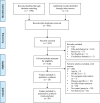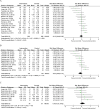Comparison between the effects of exergame intervention and traditional physical training on improving balance and fall prevention in healthy older adults: a systematic review and meta-analysis
- PMID: 34819097
- PMCID: PMC8611920
- DOI: 10.1186/s12984-021-00917-0
Comparison between the effects of exergame intervention and traditional physical training on improving balance and fall prevention in healthy older adults: a systematic review and meta-analysis
Abstract
Objective: Physical training (PT, e.g., Tai Chi and strength training) has been demonstrated to improve balance control and prevent falls. Recently, exergame intervention (EI) has emerged to prevent falls by enhancing both physical and cognitive functions in older adults. Therefore, we aim to quantitatively assess and compare the effects of PT and EI on the performance of balance control and fall prevention in healthy older adults via meta-analysis.
Methods: A search strategy based on the PICOS principle was used to find the publication in the databases of PubMed, EMBASE, Web of Science, Cochrane Library, and MEDLINE. The quality and risk of bias in the studies were independently assessed by two researchers.
Results: Twenty studies consisting of 845 participants were included. Results suggested that as compared to PT, EI induced greater improvement in postural control (sway path length, SMD = - 0.66, 95% CI - 0.91 to - 0.41, P < 0.001, I2 = 0%; sway speed, SMD = - 0.49, 95% CI - 0.71 to - 0.27, P < 0.001, I2 = 42%) and dynamic balance (SMD = - 0.19, 95% CI - 0.35 to - 0.03, P = 0.02, I2 = 0%) in healthy older adults. The EI with 90-119 min/week for more than 8-week significantly reduced falls. Subgroup analyses revealed that exergames, which were designed by the two principles of repeatedly performing diversified tasks and gradually increase the difficulty of the task, induced significant effects in improving balance control and falls prevention respectively (P = 0.03, P = 0.009). In addition, intervention that combines EI and PT induced significant improvement in postural control (P = 0.003).
Conclusion: The exergame intervention, especially the combination of EI and PT, is a promising strategy to improve balance control and reduce falls in healthy older adults. Future studies with rigorous design, larger sample size, and follow-up assessments are needed to further assess the effectiveness of diverse exergame interventions in fall prevention and to quantify the "dose-effect" relationship, as well as the carry-over effect of such intervention, which will ultimately help optimize the rehabilitative strategies to improve balance control and prevent falls.
Keywords: Balance; Exergame; Fall prevention; Meta-analysis; Older adults; Systematic review.
© 2021. The Author(s).
Conflict of interest statement
The authors declare that they have no competing interests.
Figures







Similar articles
-
The effect of Tai Chi in elderly individuals with sarcopenia and frailty: A systematic review and meta-analysis of randomized controlled trials.Ageing Res Rev. 2022 Dec;82:101747. doi: 10.1016/j.arr.2022.101747. Epub 2022 Oct 9. Ageing Res Rev. 2022. PMID: 36223875
-
Movements of older adults during exergaming interventions that are associated with the Systems Framework for Postural Control: A systematic review.Maturitas. 2018 May;111:90-99. doi: 10.1016/j.maturitas.2018.03.005. Epub 2018 Mar 15. Maturitas. 2018. PMID: 29673837
-
Multifactorial and multiple component interventions for preventing falls in older people living in the community.Cochrane Database Syst Rev. 2018 Jul 23;7(7):CD012221. doi: 10.1002/14651858.CD012221.pub2. Cochrane Database Syst Rev. 2018. PMID: 30035305 Free PMC article.
-
VR exergame interventions among older adults living in long-term care facilities: A systematic review with Meta-analysis.Ann Phys Rehabil Med. 2023 Apr;66(3):101702. doi: 10.1016/j.rehab.2022.101702. Epub 2022 Dec 1. Ann Phys Rehabil Med. 2023. PMID: 36028201
-
Psychological and/or educational interventions for the prevention of depression in children and adolescents.Cochrane Database Syst Rev. 2004;(1):CD003380. doi: 10.1002/14651858.CD003380.pub2. Cochrane Database Syst Rev. 2004. Update in: Cochrane Database Syst Rev. 2011 Dec 07;(12):CD003380. doi: 10.1002/14651858.CD003380.pub3. PMID: 14974014 Updated.
Cited by
-
Effectiveness of Exergames on Functional Physical Performance in Older Adults with Knee/Hip Osteoarthritis: A Randomized Controlled Trial.J Clin Med. 2025 Apr 25;14(9):2968. doi: 10.3390/jcm14092968. J Clin Med. 2025. PMID: 40363999 Free PMC article.
-
Video Gaming in Older People: What Are the Implications for Cognitive Functions?Brain Sci. 2024 Jul 21;14(7):731. doi: 10.3390/brainsci14070731. Brain Sci. 2024. PMID: 39061471 Free PMC article. Review.
-
Interaction between cognitive and motor disorders for risk screening of incident falls: results of an elderly population-based observational cohort study.Aging Clin Exp Res. 2023 May;35(5):1027-1032. doi: 10.1007/s40520-023-02392-0. Epub 2023 Mar 30. Aging Clin Exp Res. 2023. PMID: 36995459
-
Rehabilitation Engineering Research Center on Mobile Rehabilitation: State of the Science Conference Report-Future Directions for mRehab for People with Disabilities.Int J Environ Res Public Health. 2025 Mar 31;22(4):532. doi: 10.3390/ijerph22040532. Int J Environ Res Public Health. 2025. PMID: 40283757 Free PMC article.
-
Effects of Exergaming on Frailty: A Systematic Review and Meta-Analysis.J Clin Nurs. 2025 May;34(5):1913-1930. doi: 10.1111/jocn.17672. Epub 2025 Jan 28. J Clin Nurs. 2025. PMID: 39871670 Free PMC article.
References
-
- Rubenstein LZ. Falls in older people: epidemiology, risk factors and strategies for prevention. Age Ageing. 2006;35(suppl 2):ii37–41. - PubMed
-
- Scheffer AC, Schuurmans MJ, Van Dijk N, Van Der Hooft T, De Rooij SE. Fear of falling: measurement strategy, prevalence, risk factors and consequences among older persons. Age Ageing. 2008;37(1):19–24. - PubMed
-
- Sylliaas H, Idland G, Sandvik L, Forsen L, Bergland A. Does mortality of the aged increase with the number of falls? Results from a nine-year follow-up study. Eur J Epidemiol. 2009;24(7):351–355. - PubMed
-
- Yeşilyaprak SS, Yıldırım MŞ, Tomruk M, Ertekin Ö, Algun ZC. Comparison of the effects of virtual reality-based balance exercises and conventional exercises on balance and fall risk in older adults living in nursing homes in Turkey. Physiother Theory Pract. 2016;32(3):191–201. - PubMed
-
- Ambrose AF, Paul G, Hausdorff JM. Risk factors for falls among older adults: a review of the literature. Maturitas. 2013;75(1):51–61. - PubMed
Publication types
MeSH terms
LinkOut - more resources
Full Text Sources
Medical

